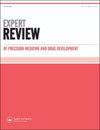胆管癌的精确肿瘤学:临床试验设计和靶向治疗的当前问题
IF 1.2
Q4 PHARMACOLOGY & PHARMACY
Expert Review of Precision Medicine and Drug Development
Pub Date : 2021-11-29
DOI:10.1080/23808993.2021.2008144
引用次数: 1
摘要
胆管癌(CCAs)包括一组异质性肝胆肿瘤,约占原发性肝癌的10-15%[1]。不幸的是,这些肿瘤中的大多数都是在晚期诊断的,在标志性的三期ABC-02试验发表十多年后,吉西他滨-顺铂作为转移性CCA的一线标准,该患者群体的预后仍然严峻[2]。事实上,大多数接受一线治疗的患者都没有达到反应或反应是短暂的[3]。近年来,在这种情况下出现了分子图谱,新技术和技术导致了CCA中各种分子变化的鉴定[4]。在过去的十年里,一些潜在的可操作的遗传畸变已经被强调,精确肿瘤学方法已经被评估,并正在这些肝胆恶性肿瘤中进行研究(图1)。目前正在开发大量抗癌药物,包括成纤维细胞生长因子受体(FGFR)2、异柠檬酸脱氢酶1(IDH-1)和BRAF抑制剂[5]。据报道,大约20%的肝内胆管癌(iCCA)中存在FGFR2异常,这些变化在女性患者和年轻人中最为常见[6]。值得注意的是,FGFR2畸变主要表现为融合,而突变仅在少数患者中检测到。关于IDH-1,错义突变是最常见的畸变,涉及酶活性位点的单个残基[7];通常,据报道,IDH-1错义突变在小管型iCCA和低分化或未分化形式中更常见[8]。在CCA患者中观察到其他几种分子畸变,包括BRCA突变、NTRK融合和BRAF V600E突变[9,10]。尽管如此,仍有几个问题没有得到解答,CCA患者采用精确肿瘤学仍远未达到日常临床实践,只有一些重要的例外。在目前的障碍中,需要强调的一个关键点是获得抗癌治疗的机会有限。例如,尽管已经提交了ClarIDHy III期试验的最终总生存期(OS)分析,并且在2021年8月25日,美国食品药品监督管理局批准了伊沃西替尼在IDH-1突变体iCCA中的使用,但根据监管机构的不同选择,IDH-1抑制剂在几个国家不可用[11]。其次,活检样本通常不足以进行分子图谱分析,因为据报道,组织取样在诊断恶性胆道狭窄方面的敏感性较低;事实上,CCA的高促结缔组织增生性严重限制了病理学和细胞学方法的准确性。基于这些前提,迫切需要在这种情况下开发新的策略,旨在通过在早期可切除阶段检测CCA来预测诊断,并获得足够的材料来进行基因组分析。在这些策略中,液体活检可能是一种基本工具,尽管该技术的使用仍然有限,必须在不久的将来实施[12]。CCA的基因组多样性也是一个长期存在的问题,它也反映了解剖、流行病学和治疗的差异。事实上,目前众所周知,这些恶性肿瘤不应被视为一个单一的实体,而是一组具有异质性特征的肿瘤。然而,一些试验仍然将不同的解剖CCA亚组分组在一起,如iCCA、肝门周围CCA和远端CCA,这代表了这些肝胆恶性肿瘤临床试验设计中的“历史”问题。在这些肿瘤的研究中,应始终根据CCA亚组对患者进行分层,同时考虑到不同的亚组与不同的分子特征、临床结果和预后有关。在我们看来,这种情况下的另一个里程碑式的主题是临床试验登记,这仍然是CCA的优先事项,因为在登记这些罕见的肝胆肿瘤患者时遇到了困难。例如,ClarIDHy和FIGHT-202分别对伊沃西替尼和培米吉尼进行的试验招募了100多名CCA患者,需要在筛查和招募方面做出重要努力[13-15]。同样,评估达非尼加曲美替尼治疗BRAF V600E突变CCA的II期单臂ROAR试验的研究人员必须对626名受试者进行预筛选,以招募43名CCA患者,这一数字突显了完成此类试验的困难[16]。在罕见的具有遗传畸变的CCA亚组中进行临床研究仍然是一个令人信服的挑战,在这种情况下,国际合作至关重要。本文章由计算机程序翻译,如有差异,请以英文原文为准。
Precision oncology in cholangiocarcinoma: current issues in clinical trial design and access to targeted therapies
Cholangiocarcinomas (CCAs) include a heterogeneous group of hepatobiliary tumors accounting for approximately the 10–15% of primary liver cancers [1]. Unfortunately, most of these tumors are diagnosed at an advanced stage, and more than ten years after the publication of the landmark phase III ABC-02 trial establishing gemcitabine-cisplatin as first-line standard for metastatic CCA, the prognosis of this patient population remains grim [2]. In fact, most of patients treated with front-line treatment fail to achieve a response or responses are short lived [3]. Recent years have witnessed the advent of molecular profiling in this setting, and new techniques and technologies have led to the identification of a variety of molecular alterations in CCA [4]. Over the last decade, several potentially actionable genetic aberrations have been highlighted, and precision oncology approaches have been evaluated and are under investigation in these hepatobiliary malignancies (Figure 1). A large number of anticancer agents are currently in development, including Fibroblast Growth Factor Receptor (FGFR) 2, Isocitrate Dehydrogenase 1 (IDH-1), and BRAF inhibitors [5]. FGFR2 aberrations have been reported in approximately the 20% of intrahepatic cholangiocarcinomas (iCCAs), with these alterations highlighted as most common in female patients and young adults [6]. Of note, FGFR2 aberrations are mainly represented by fusions, while mutations are detected only in a minority of patients. As regards IDH-1, missense mutations are the most frequent aberrations, involving a single residue in the active site of the enzyme [7]; typically, IDH-1 missense mutations have been reported to be more common in small duct type iCCAs and in poorly differentiated or undifferentiated forms [8]. Several other molecular aberrations have been observed in CCA patients, including BRCA mutations, NTRK fusions, and BRAF V600E mutations [9,10]. Nonetheless, several questions remain unanswered, and the adoption of precision oncology in CCA patients remains still far from everyday clinical practice, with some important exceptions. Among current obstacles, a crucial point to highlight is the limited access to anticancer treatments. For example, although the final overall survival (OS) analysis of the ClarIDHy phase III trial has been presented and on 25 August 2021 the FDA approved ivosidenib use in IDH-1 mutant iCCA, the IDH-1 inhibitor is not available in several countries, according to different choices by the regulatory agencies [11]. Second, biopsy samples are often inadequate for molecular profiling since tissue sampling has reported low sensitivity in the diagnosis of malignant biliary strictures; in fact, the highly desmoplastic nature of CCA severely limits the accuracy of pathological and cytological methodologies. On the basis of these premises, it is urgent to develop in this scenario novel strategies aimed at anticipating the diagnosis by detecting CCA at an early, resectable stage, as well as to obtain adequate material to perform genomic analysis. Among these strategies, liquid biopsy may represent a fundamental tool, although the use of this technique is still limited and has to be implemented in the near future [12]. A long-standing issue is also represented by the genomic diversity of CCAs that also mirrors anatomical, epidemiological, and therapeutical differences. In fact, it is currently well known that these malignancies should not be considered as a single entity but a group of tumors with heterogeneous features. However, several trials still group together different anatomical CCA subgroups, such as iCCA, perihilar CCA, and distal CCA, something that represents a ‘historical’ issue in clinical trial design in these hepatobiliary malignancies. Stratification of patients according to CCA subgroup should always be present in studies on these tumors, also considering that distinct subgroups are associated to different molecular features, clinical outcomes and prognosis. In our opinion, another landmark topic in this setting is represented by clinical trial enrollment, something that remains a priority in CCA due to the difficulties encountered in enrolling patients with these rare hepatobiliary tumors. For example, the ClarIDHy and the FIGHT-202 trials on ivosidenib and pemigatinib, respectively, enrolled more than a hundred CCA patients, requiring important efforts in terms of screening and enrollment [13–15]. Similarly, the investigators of the phase II, singlearm, ROAR trial evaluating dabrafenib plus trametinib in BRAF V600E-mutated CCAs, had to prescreen 626 subjects to enroll 43 CCA patients, a figure that highlights the difficulties in completing such a trial [16]. Conducting clinical studies in rare CCA subgroups with genetic aberrations remains a compelling challenge, and international collaborations are of pivotal importance in this setting. This is even more important in CCA patients whose disease has progressed following first-line or
求助全文
通过发布文献求助,成功后即可免费获取论文全文。
去求助
来源期刊

Expert Review of Precision Medicine and Drug Development
PHARMACOLOGY & PHARMACY-
CiteScore
2.30
自引率
0.00%
发文量
9
期刊介绍:
Expert Review of Precision Medicine and Drug Development publishes primarily review articles covering the development and clinical application of medicine to be used in a personalized therapy setting; in addition, the journal also publishes original research and commentary-style articles. In an era where medicine is recognizing that a one-size-fits-all approach is not always appropriate, it has become necessary to identify patients responsive to treatments and treat patient populations using a tailored approach. Areas covered include: Development and application of drugs targeted to specific genotypes and populations, as well as advanced diagnostic technologies and significant biomarkers that aid in this. Clinical trials and case studies within personalized therapy and drug development. Screening, prediction and prevention of disease, prediction of adverse events, treatment monitoring, effects of metabolomics and microbiomics on treatment. Secondary population research, genome-wide association studies, disease–gene association studies, personal genome technologies. Ethical and cost–benefit issues, the impact to healthcare and business infrastructure, and regulatory issues.
 求助内容:
求助内容: 应助结果提醒方式:
应助结果提醒方式:


